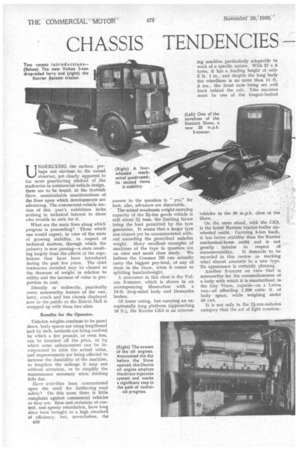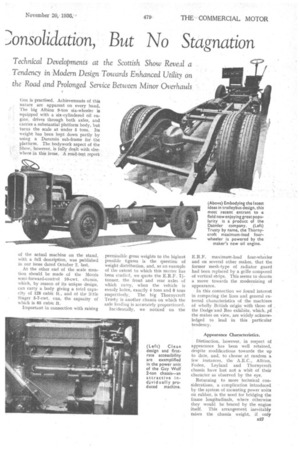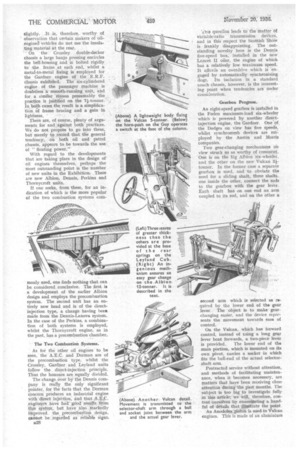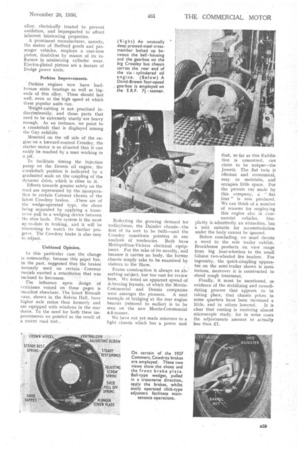CHASSIS TENDENCIES
Page 40

Page 41

Page 42

Page 43

If you've noticed an error in this article please click here to report it so we can fix it.
Th,onsolidation, But No Stagnation
Technical Developments at the Scottish Show Reveal a Tendency in Modern Design Towards Enhanced Utility on the Road and Prolonged Service Between Minor Overhauls
UNDERLYING the surface, perhaps not obvious to the casual observer, yet clearly apparent to the more penetrating student of the tendencies in commercial-vehicle design, there are to be found, at the Scottish Show, unmistakable manifestations of the lines upon which developments are advancing. The commercial-vehicle section of this year's exhibition lacks nothing in technical interest to those who trouble to seek for it.
What are the main lines along which progress is proceeding? Those which one would expect, in view of the state of growing stability, in respect of technical matters, through which the industry is now passing—a state resulting largely from the effects of the regulations that have been introduced during the past few years. The chief tendencies revealed may be classed as the decrease of weight in relation to utility and the increase of value in proportion to cost.
Directly or indirectly, practically every noteworthy feature of the van, lorry, coach and bus chassis displayed now to the public at the Kelvin Hall is wrapped up with these two aims.
Benefits for the Operator.
Unladen weights continue to he pared down, body spaces are being lengthened inch by inch, methods are being evolved by which a few pounds, or even less, can be knocked of the price, or by which some enhancement can be incorporated to raise the actual value, and improvements are being effected to increase the durability of the machine. to lengthen the mileage it may run without attention, or to simplify the maintenance necessary when docking falls due.
Have activities been concentrated upon the need for furthering road safety? On this score there is little complaint against commercial vehicles as they are. Ease and certainty of control, and speedy retardation, have long since been brought to a high standard of efficiency, but, nevertheless, the n26 answer to the question is " yes," for here, also, advances are discernible.
The actual maximum weight-carrying capacity of the 2i-ton goods vehicle is still about 51 tons, the limiting factor being the load permitted by the tyre guarantee. It seems that a larger tyre size cannot yet be accommodated without exceeding the prescribed unladen weight. Many excellent examples of machines of the type in question are on view and merit close study. We believe the Commer N5 can actually carry the biggest pay-load, of any of these in the Show, when it comes to splitting hundredweight.
A newcomer in this class is the Vulcan 5-tonner, which is shown in an accompanying illustration with a 14-ft. drop-sided body and Dewandre brakes.
Of lower rating, but carrying an exceptionally long platform (approaching 18 ft.), the Karrier CK3 is an interest log machine particularly adaptable to work of a specific nature. With 27 x 6 tyres, it has a loading height of only 2 ft. 1 in., and despite the long body the wheelbase is no more than 11 ft.
3 ins., the front axle. being set well back behind the cab. This machine must be one of the longest-bodied
vehicles in the 30 m.p.h. class at the Show.
On the s.ame stand, with the CK3, is the latest Bantam tractor-trailer sixwheeled outfit, Carrying 5-ton loads, it has better stability than the Karrier mechanical-horse outfit and is not greatly inferior in respect of manceuvrability. It demands to be recorded in this review as marking what almost amounts to a new type. Its appearance is certainly pleasing.
Another 3-tonner on view that is noteworthy for the commodiousness of a body with which it is standardized, is the Guy Vixen, capable—as a Luton van—of affording 1,200 cubic ft. of body space, while weighing under 50 cwt.
It is not only in the 21-ton-unladen category that the art of light construe tion is practised. Achievements of this nature are apparent on every hand. The big Albion 9-ton six-wheeler is equipped with a six-cylindered oil engine, drives through both axles, and carries a substantial platform body, but turns the scale at under 5 tons. Its weight has been kept down partly by using a Durarnin sub-frame for the platform. The bodywork aspect of the Show, however, is fully dealt with ekewherein this issue. A road-test report of the actual machine on the stand, with a full description, was published in our issue dated October 2, last.
At the other end of the scale mention should be made of the Morris semi-forward-control 10-cwt. chassis, which, by reason of its unique design, can carry a body giving a total capacity of 128 cubic ft., and of the little Singer 5-7-cwt. van, the capacity of which is 65 cubic ft.
Important in connection with raising permissible gross weights to the highest possible figures is the question of weight distribution, and, as an example of the extent to which this matter has been studied, we quote the E.R.F. 7itonnes, the front' and rear axles of which early, when the vehicle is evenly laden, exactly 4 tons and 8 tons respectively, The big Thornycroft Trusty is another chassis on which the axle loading is accurately proportioned.
Incidentally, we noticed on the E.R.F. maximum-load four-wheeler and on several other makes, that the former mesh-type of radiator guard had been replaced by a grille composed of vertical strips. This seems to denote a move towards the modernizing of appearance.
In this connection we found interest in comparing the lines and general external characteristics of the machines of wholly British origin with those of the Dodge 'and Reo exhibits, which, pf the makes on view, are widely acknowledged to lead in this particular tendency,
Appearance Characteristics.
Distinction, however, in respect of appearance has been well retained, despite modifications towards the up to date, and, to choose at random a few instances, the A.E.C., Foden, Leyland and Thornycroft chassis have lost not a whit of their character as observed by the eye.
Returning to more technical considerations, a complication introduced by the system of mounting power units on rubber, is the need for bridging the frame longitudinals, where otherwise they would be braced by the engine itself. This arrangement inevitably raises the chassis weight, if only slightly. It is, therefore, worthy of observation that certain makers of oilengined vehicles do not use the insulating material at the rear.
On the Crossley double-decker chassis a large banjo pressing encircles the bell-housing and is bolted rigidly to the frame at each end, whilst a metal-to-metal fixing is employed for the Gardner engine of the E.R.F. chassis exhibited. The six-cylindered engine of the passenger machine is doubtless a smooth-running unit, and for a similar reason presumably the practice is justified on the 71-tonner. In both cases the result is a simplification_ of frame bracing and a gain in lightness.
There are, of course, plenty of arguments for and against both practices. We do not propoSe to go into these, but merely to record that the general tendency, on both oil and petrol chassis, appears to be towards the use of "floating power."
With regard to the developments that are taking place in the design of oil engines themselves, perhaps the most outstanding point is the number of new units in the Exhibition. There are new Albion, Dennis, Perkins and Thornycroft units.
If one seeks, from these, for an indication of which is the more popular of the two combustion systems corn
monly used, one finds nothing that can be considered conclusive. The first is a development of the earlier Albion design and employs the precombustion system. The second unit has an entirely new head and is of the directinjection type, a change having been made from the Dennis-Lanova system. In the case of the Perkins, a combination of both systems is employed, whilst the Thornycroft engine, as in the past, has a precombustion chamber.
The Two Combustion Systems.
As for the other oil engines to be seen, the A.E.C. and Dorman are of the precombustion type, whilst the Crossley, Gardner and Leyland units follow the direct-injection principle. Thus the honours are equally divided.
The change over by the Dennis company is really the only significant pointer, for the facts that the Dorman concern produces an industrial engine with direct injection, and that A.E,C. engineers have had good results from this system, but have also .Markedly improved the precombustion design, cannot be regarded as reliable signs.
B2S
'fists question leads -to the matter of variablesratio transmission devices, and in this respect the Scottish Show is frankly disappointing. The outstanding novelty here is the Dennis five-speed box, installed in the new Lancet II oiler, the engine of which has a relatively low maximum speed. It affords an overdrive which is 'engaged by automatically synchronizing dogs. Its inclusion in a standard coach chassis, however, is the interesting point when tendencies are under consideration.
Gearbox Progress.
An eight-speed gearbox is installed in the Foden maximum-load six-wheeler which is powered by another 'directinjection engine, the Gardner. One of the Dodges on view has five speeds, whilst synchromesh devices are ern.ployed by the Austin and Morris companies.
Two gear-changing mechanisms oh view struck us as worthy of comment. One is on the big Albion 'six-wheeler, and the other on the new Vulcan 2f tonnes. In the former case a separate gearbox is used, and 'to obviate the need for a sliding shaft, three shafts, one inside the other, connect the rods to the gearbox with the gear lever. Each shaft has on one end an arm coupled to its rod, and on the other a
second arm which is selected at required by the lower end of the gear lever. The object is to make gearchanging easier, and the device represents the movement towards ease of control.
On the Vulcan, which has forward control, instead of using a long gear lever bent forwards, a two-piece lever is provided. The lower end of the main portion, which is mounted on its own pivot, carries a socket in which fits the ball-end of the actual selectorshaft arm.
Protracted service without attention, and methods of facilitating maintenance, when it becomes necessary, are matters that have been receiving close attention daring the past months. The subject is too big to investigate fully In this article; we will, therefore, content ourselves by enumerating a handful of details that illustrate the point.
An AnodoIex piston is used in Vulcan engines. This is made of an aluminium alloy, electrically treated to prevent oxidation, and impregnated to afford inherent lubricating properties.
A prominent manufacturer, namely, the maker of Bedford goods and passenger vehicles, employs a cast-iron piston, doubtless by reason of its influence in minimizing cylinder wear. Electro-plated pistons are a feature of Dodge power units.
Perkins Improvements.
Perkins engines now have leadbronze niain bearings as well as bigends of this alloy. These should last well, even at the high speed at which these popular units run.
Weight-cutting is not practised indiscriminately, and those parts that need to be extremely sturdy are heavy enough. As an instance, we point to a crankshaft that is displayed among the Guy exhibits.
Mounted on the off side of the engine on a forward-control Crossley, the starter. motor is so situated that it can easily be reached by a man working in a pit. _ To facilitate timing the injection pump on the Dennis oil engine, the crankshaft position is indicated by a graduated scale on the coupling of• the dynamo drive, which is close to it. '
Efforts towards greater safety on the road, are represented by the incorporation in certain Commer chassis of the latest Cowdrey brakes. „These are of the wedge-operated type, the shoes being separated by applying a transverse pull to a wedging device between the shoe heels. The system is the most up-to-date in braking, and it will be interesting to watch its further progre.:-.s. The Cowdrey brake is also easy to adjust.
Unbiased Opinion.
In this particular case the change is noteworthy, because this paper has, in the past, suggested that the brakes formerly used on certain Commer models exerted a retardation that was inclined to fierceness.
The influence upon design of criticisms voiced on these pages is manifest elsewhere. The latest Renault vans, shown in the Kelvin Hall, have higher axle ratios than formerly and are equipped with windows in the rear doors. To the need for both these improvements we pointed as the result of a recent road test., Reflecting the growing demand for trolleybuses, the Daimler chassis—the first of its sort to be built—and the Crossley constitute pointers in our analysis of tendencies. Both have Metropolitan-Vickers electrical equipment. For the sake of its novelty, and because it carries no body, the former chassis simply asks to be examined by visitors to the Show.
Frame construction is always an absorbing subject, but too vast for review here. We noted an apparent spread of A-bracing layouts, of which the MorrisCommercial and Dennis companies were amongst the pioneers. A neat example of bridging at the rear engine bearers (referred to earlier) is to be seen on the new Morris-Commercial 4-5-tonner.
We have not yet made reference to a light chassis which has a power unit
that, so far as this Exhibition is concerned, can claim to be unique—the Jowett. The flat twin is efficient and economical, easy to maintain, and occupies little space. For the private car made by this company, a " flat four" is now produced. We can think of a number of reasons for employing this engine also in commercial vehicles. Simplicity is admittedly an attraction, but a unit suitable for accomModation under the body cannot be ignored.
Before concluding, we must devote a word to the sole trailer exhibit. Brockhouse products on view range from big four-wheelers to the small Gibson two-wheeled fore tenders. For ingenuity, the quick-Coupling -apparatus on the semi-trailer shown is meritorious, moreover it is constructed to stand rough treatment.
Finally, it must be mentioned, as evidence of the stabilizing and consolidating process that appears to be taking place, that chassis prices •in some quarters have been increased a
little, and in others lowered. It is clear that costing is receiving almost microscopic study, for in some cases the adjustments amount to actually less than




























































































